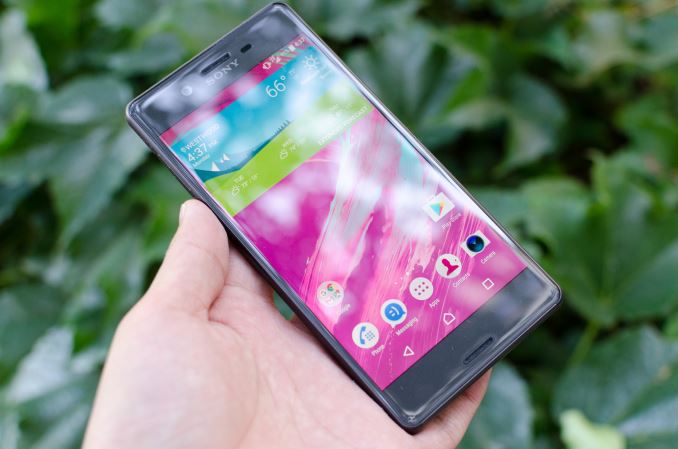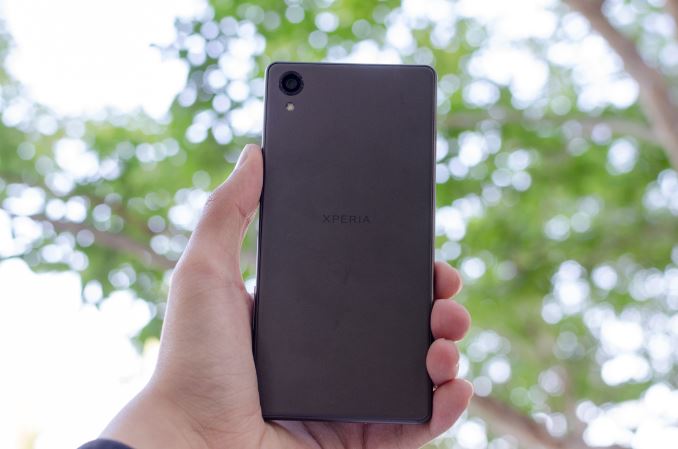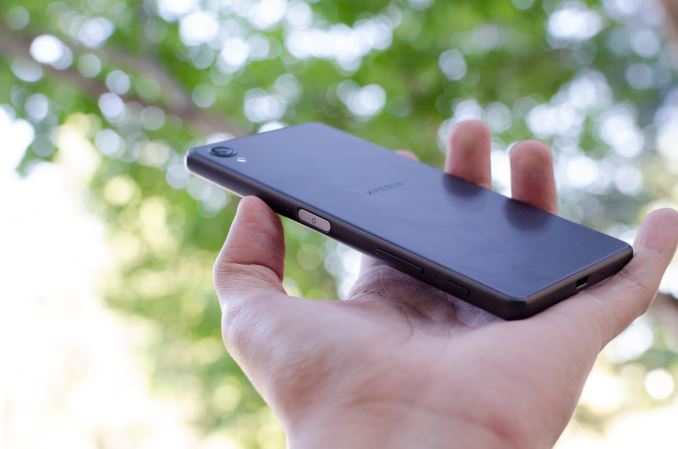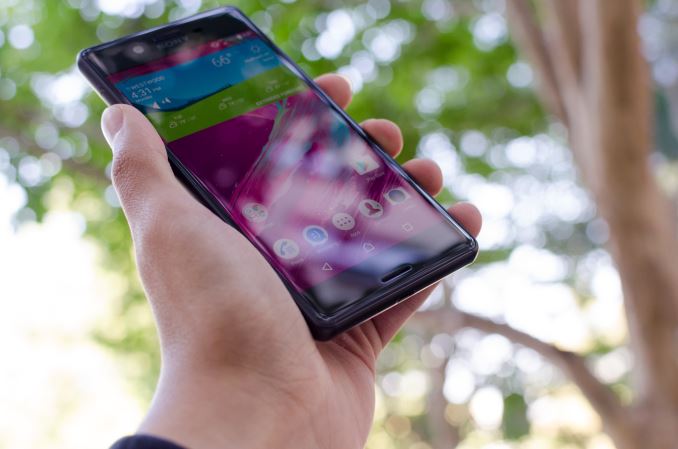The Sony Xperia X Preview
by Joshua Ho on May 31, 2016 8:02 AM EST- Posted in
- Smartphones
- Snapdragon
- Sony
- Qualcomm
- Mobile
- Xperia
- Snapdragon 650
- Xperia X

For some time now, Sony has been mostly absent from the US market. While we’ve seen devices here and there, there have been issues with keeping launches aligned, and for the most part by the time an Xperia phone launches in the US it’s already on the verge of being irrelevant as the 6 month launch cycle of Xperia phones in the past meant that slipping by even a few months resulted in noticeable deltas when comparing US and international models.
With the Xperia X, this all changes. Sony finally appears to be taking the US market seriously again, and I’ve spent the last few days using and testing the Xperia X to see just how it stacks up against the competition. The Xperia X is designed to unify the smartphone lineup to some extent, which makes some kind of sense when even I can’t really keep track of all the Sony smartphones other than the Z line. With the Xperia X Performance, X, XA, and XA Ultra there’s some semblance of sanity to the lineup. The X proper represents the high-end, while the XA line represents the mid-range.
While the astute readers may have noticed that we have tested Xperia phones before, we’ve never done a true review of one. To start reviewing the Xperia X, we can start with the usual spec sheet.
| Sony Xperia X | Sony Xperia X Performance | |
| SoC | Snapdragon 650 2x Cortex-A72 @ 1.8Ghz 4x Cortex-A53 @ 1.4GHz Adreno 510 (TSMC 28HPm) |
Snapdragon 820 2x Kryo @ 2.15GHz 2x Kryo @ 1.6GHz Adreno 530 (Samsung 14LPP) |
| RAM | 3GB LPDDR3 | 3GB LPDDR4 |
| NAND | 32/64GB NAND + microSD | 32/64GB NAND + microSD |
| Display | 5” 1080p Triluminos LCD |
5” 1080p Triluminos LCD |
| Network | 2G / 3G / 4G LTE (Category 7 LTE) | 2G / 3G / 4G LTE (Category 6/9 LTE) |
| Dimensions | 142.7 x 69.4 x 7.9mm, 153g | 143.7 x 70.4 x 8.7mm, 164g |
| Camera | 23MP Rear Facing w/ EIS, f/2.0, 1.12µm, 1/2.3" | 23MP Rear Facing w/ EIS, f/2.0, 1.12µm, 1/2.3" |
| 13MP Front Facing, f/2.0, 1.12µm | 13MP Front Facing, f/2.0, 1.12µm | |
| Battery | 2620 mAh (10.09 Whr) | 2700 mAh (10.4 Whr) |
| OS | Android 6 w/ Xperia UI (At Launch) |
Android 6 w/ Xperia UI (At Launch) |
| Connectivity | 802.11a/b/g/n/ac, BT 4.2, USB2.0,GPS/GLONASS, NFC |
802.11a/b/g/n/ac, BT 4.2, USB2.0,GPS/GLONASS, NFC |
| Fingerprint Sensor | Capacitive (non-US only) | Capacitive (non-US only) |
| SIM | NanoSIM | NanoSIM |
At a high level, the Xperia X is a well-balanced phone due to the 5” display, large camera sensor, but for the most part it’s a decidedly upper-mid-range phone. For the most part it’s pretty much a high-end phone other than the SoC, which is Qualcomm’s Snapdragon 650 SoC. For those unfamiliar with this SoC I would refer to our previous coverage on these SoCs for a high level overview. The battery does appear to be on the small side, but given the overall size and display size it’s in line with expectation. At first glance, the only real concern I have is the camera, as Sony lists this camera to have a 24mm equivalent focal length. While I try to keep an open mind with these things, this immediately jumps out as something concerning.
Of course, while spec sheets can give some idea for what to expect, there is a whole ocean of implementation details going from a spec sheet to an actual phone. To start, we can look at the design of the Xperia X, which is clearly an evolution of the Omni-Balance design that was first seen with the original Xperia Z. If you’ve used the Xperia Z3, the Xperia X will probably be quite familiar in feel, but instead of an aluminum frame and glass back, the Xperia X uses a plastic frame and an aluminum back that appears to have a sand-blasted anodized finish. I do have to admit it is a bit disappointing to me that Sony didn’t go all the way with an aluminum unibody design here, but it does feel easier to grip than the rather slippery Xperia Z3.
The plastic frame also has sensible button and port placement, which is good to see as previous Xperia smartphones were profoundly strange in that respect. The microUSB port is on the bottom of the phone, the combined SIM/microSD tray on the left side when viewed from the front, and the power button is placed high enough that if you hold the phone with your right hand your thumb should be approximately in the correct position to easily access it. This power button also doubles as a fingerprint scanner for international units but not US ones, which has been surprisingly fast when it works and has a firm feel unlike the somewhat loose fingerprint scanner on the LG G5. The volume rocker and two-stage camera button are just below the power button, and for the most part I don’t really have any issues with the placement here. The feel of the buttons is solid here and there’s no creep or take-up before the break. The camera button works, but the feel of the first stage isn’t very consistent as if your finger placement varies it won’t feel the same, and the break of the second stage feels a bit springy if you’re used to something like the Lumia 1020’s camera button.
The front of the phone is very much reminiscent of the Xperia Z3, as the dual front-facing speakers have a similar design and Sony continues to use on screen buttons here which does have a fairly noticeable effect on usable screen space, although I’m not really allowed to tear down the phone to see whether this phone places the display driver at the top to allow for capacitive buttons to increase usable screen space.
Overall, the design of the Xperia X is solid. There’s nothing really wrong with it, although the large amount of bezel on the bottom combined with the on screen buttons means that the typing ergonomics feels somewhat similar to the One M9. The plastic frame with all of its seams is a bit disconcerting for a 550 USD phone, but it doesn’t really have a material impact on in-hand feel. Again, I think an all-aluminum unibody would probably make it feel a lot better, but for what it is I don’t have any complaints.














45 Comments
View All Comments
RichieHH - Tuesday, May 31, 2016 - link
You're joking, right? The Z3 was top of the heap in many ways. I still use mine. The Z5 is also a superb phone.Eden-K121D - Tuesday, May 31, 2016 - link
Most OEM's except for Apple or Samsung cut corners on storage , build Quality or industrial design or all of thosearnoudw - Tuesday, May 31, 2016 - link
"Of course, for those that aren’t familiar with display testing, this may seem a bit out of expectation as in general most reviews will generally state that the Xperia phones have had generally acceptable or excellent displays, but our testing here attempts to avoid relying upon subjective color preferences and rather holds all mobile displays to the same industry-wide standard for content creation on the web."I second this. I've done reviews of Sony phones on the largest Dutch website about technology, Tweakers, and howerver I've liked the battery life and feature set of Xperia smartphones of the last years a lot, the display has been a let down.
Up until the Xperia Z3 it looked like Sony didn't use ips panels at all, resulting in horrible contrast when viewed under even a small angle. And the color calibration has been consistently horrible (for example, http://tweakers.net/reviews/4228/5/sony-xperia-z5-...
This was the case on all high end Xperia smartphones without exception. All. Of. Them. The camera is the same thing. Sony is making kick ass camera sensors which power all high end phones, but camera samples from Xperia's are always noisy. It's improving, but it's not nowhere near the competition even now.
It's a shame, because we all know Sony could do so much better, but for some reason have been failing for years.
BedfordTim - Tuesday, May 31, 2016 - link
If it is does well a plastic body removes the need for a case and significantly reduces the final size of a phone so I would consider it a positive rather than negative.BedfordTim - Tuesday, May 31, 2016 - link
Sorry no edit function. I meant "If it is done well"Spectrophobic - Tuesday, May 31, 2016 - link
I was excited when they announced the X Performance, being SD820 and 1080p. But Sony still can't get screens right. Oh well...Looking forward to the OnePlus 3. Or perhaps a Nexus 5X refresh with a 820?
beginner99 - Tuesday, May 31, 2016 - link
I like the screen size but it's larger and heavier than phones with similar screens like Galaxy S7 while also having a smaller battery. And I hate on-screen buttons. Look at that last pic. bottom 20% of phone is wasted space with on-screen buttons and bezel. With the galaxy S7 (or S6 or Mi5) you get more screen real estate at lower weight and with a larger battery.techcrazy - Tuesday, May 31, 2016 - link
While benchmarking is nice way to measure a phone's performance. I would like to learn how it performs in the real world scenario. I saw couple of videos where I saw Xperia X outperform HTC 10 and LG G5 in opening apps. Joshua please focus on the real world performs as well. Thanks in advance.ikjadoon - Tuesday, May 31, 2016 - link
Yes. I understand how it is "preliminary", but I think it's quite weird to see a focus on sequential performance. When is that a bottleneck in an Android phone? I honestly don't know. Is random 4 KB access still important in day-to-day use? Is that Windows only? What queue depths are important?In a Windows SSD environment, I understand: in real-world use, every SSD under consumer applications will perform nearly identically. The only noticeable differentiator is with large file transfers: TLC vs TLC w/ caching vs MLC vs SLC (and then PCIe vs SATA protocol limitations on top of all that).
But, at QD1-4, pretty much every SSD gives similar enough numbers where normal users won't notice a difference.
---
But, with Android? I've absolutely no idea. Is random performance more or less important than sequential?
JoshHo - Tuesday, May 31, 2016 - link
The issue here is mostly that AndroBench 3.6 and 4.0 random read/write results aren't comparable so we have to retest these things.